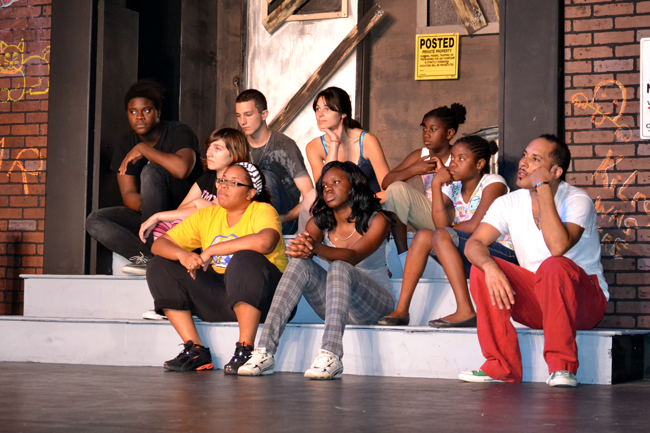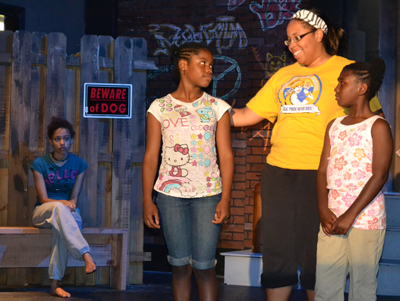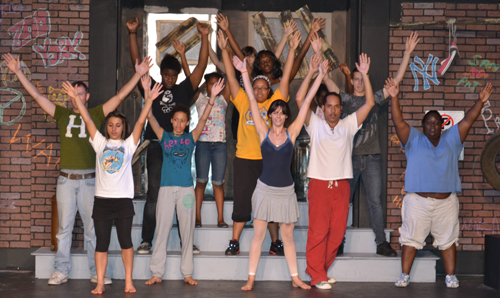
In the first week of 1969, Avon Books published a 144-page book called “The Me Nobody Knows: Children’s Voices from the Ghetto.” The 95-cent volume was a collection of prose and poetry by 200 black and Puerto Rican children living in New York City’s slums. They were collected by several teachers and edited by Stephen Joseph. The text is reproduced as written, without spelling or syntax corrections, to preserve the children’s voices whole. “The children should feel free to speak without fear of being evaluated,” Joseph wrote in the introduction.
Showtime:
- “The Me Nobody Knows,” at the Flagler Plahouse, is scheduled for nine performances: April 29, 30, May 6, 7, 13, 14 at 7:30 p.m., and Sunday matinees, May 1, 8 and 15 at 2 p.m. The Playhouse is located at 301 East Moody Blvd. in Bunnell. Call 586-0773 for tickets and details or visit the Playhouse website.
On page 32, there was this brief story, handed in without a signature: “The Beginning of this story began on February 10, 1966. I was at a party with my girl who was 16 & I was 13 ½. Then I saw my girl take out a needle. It was then that I saw the needle marks. I was so surprised that I didn’t know what to do. She went into the bedroom. I followed half stupid at what I saw. I started to talk to her about the mistake she had made, but the dope was taking affect. I felt like dieing but no. I took the needle and I took a shot to see what would happen. It was painless. When my girl got up she tried to wake me. But all I could feel were sexual affects. Then I woke up. I took 3 more shots and I was hooked. I needed the dope.”
On the stage of the Flagler Playhouse, the story is told to great effect by “Lloyd,” played by Jean Rodny Lallemand, one of a half-dozen standouts in a cast of 16 in the Playhouse production of “The Me Nobody Knows.” The 1970 musical opened Friday evening, to a very enthusiastic crowd, for a nine-performance run over the next three weekends. The play is directed by Bruce Heighley, with Bruce Popielarski, a frequent actor in Playhouse productions, in the assistant director’s job for the first time.
Click On:
- “Waiting in the Wings” at the Flagler Playhouse: Old Age in Wit and Drink
- You Can’t Stop the Beat: Flagler Playhouse’s “Hairspray” Sells Out Extended Run
- “Jesus Christ Superstar” Launches Flagler Playhouse’s 32nd Season
- From Raves to Shock: Flagler Playhouse’s Artistic Director and President Both Resign
There is no plot in “The Me Nobody Knows.” There doesn’t need to be. Shattering and sometimes bitter stories like Lloyd’s alternate with musical numbers—sunny, joyful numbers, most of them, using that 1970s folk-rock beat and hand-quivering choreography to echo these children’s hopes. There’s bitterness but no cynicism. There’s loneliness. And there’s realism, a raw awareness of the rats and filth and bloodied sceneries of the ghetto, of a father’s beatings or a teacher’s indifference. But there’s also a constant look beyond, literally to the stars above and to an inner joy for life these children carry within them and project in spite of the demons around them. The music, written by Gary William with lyrics by Will Holt, amplifies their joys and occasional sorrows in tune with their daily lives. The music in “Hairspray,” the Playhouse’s previous—and extremely successful—musical, achieved the safe effect, though no one in “The Me Nobody Knows” is a caricature so much as a mosaic.
In what’s been a running theme this season at the Playhouse, “The Me Nobody Knows” is a daring play, demanding emotionally and physically for a cast whose youngest actors—Zameena Phillips and Ashana Jones—aren’t yet teenagers and whose oldest are barely past being so. Most are in between. Slums aren’t their everyday experiences by any means. But adolescence is by nature a psychological ghetto adults do their best alternately to circle, control, judge and avoid. Those actors are in the thick of it: they know that much, and exploit the feelings convincingly.
The Live Review
Lallemand conveys the bemusement and vulnerability of teens assaulted by situations and individuals they can’t possibly understand, yet. Phillips’s Lillie Mae does her best to hold on to what shreds remain of childhood innocence, to the ridicule of her older peers. (Lillie Mae’s role was played by Irene Cara in the original, at the Orpheum Theater in New York.). Nella Dixon’s Nell and Robby Howell’s Donald, two of the most effective cast members, are all wit and irony the moment they open their mouths (and vocal cords), though Nell’s wit is earnest and sweet where Donald’s, hostage to his machismo, is cutting and insecure, and no less hilarious for it.
One of Dixon’s best moments, aside from her singing, is when she tells the story of G.P., a 16-year-old child writing from a youth detention house in the original book, about the many jobs criminals create for others—cops (in uniform and plainclothes), prison builders, judges, lawyers, court reporters, secretaries, wardens, guards, and directors of youth detention houses, among many others.
“Now I ask you,” Dixon’s Nell goes on with a wag of fingers and eyes, “doesn’t the criminal provide jobs for thousands? Therefore I feel that all criminals should be treated with consideration, due to their advancement of industry.” That got quite a bit of applause and a “she has a point” from a woman in the audience. Rare empathy in a society as much in love with prisons as it’s in hate with prisoners.
If there’s one performer (and character) you never get enough of on this stage, it’s Tyrique Harper. A senior at Matanzas High School, he’d never been on stage until this year, when he was part of the “Hairspray” cast at the Playhouse. You wouldn’t know he was a rookie. “Tyrique is a member of his school’s track team,” the playbill tells us, “and the agility he learned there helps enhance his dancing style.” And his acting style: He’s a full-bodied performer up to the darting black-and-white dance of his eyes. He delivers some of the more poetic lines in the play, but the words are only half his story. His body, his muscles, rhyming to his words, tell the other half.
Harper’s Clorox provides the dramatic highlight of the evening with his “What Am I” soliloquy half-way through the first act. It’s worth reproducing in full here, though the words alone have none of the power Harper’s performance, defiant and in the audience’s face:
I have no manhood—what am I?
You made my woman head of the house—what am I?
You have oriented me so that I hate and distrust my brothers and sisters—what am I?
You mispronounce my name and say I have no self-respect—what am I?
You give me a dilapidated education system and expect me to compete with you—what am I?
You say I have no dignity and then deprive me of my culture—what am I?
You call me a boy, dirty lowdown slut—what am I?
Now I’m a victim of the welfare system—what am I?
You tell me to wait for change to come, but 400 years have passed and change ain’t come—what am I?
I am all of your sins
I am the skeleton in your closets
I am the unwanted sons and daughters in-laws, and rejected babies
I may be your destruction, but above all I am, as you so crudely put it, your nigger.

Harper’s counterpoint is Kaylee Rotunno (“Leggs”), a fellow senior at Matanzas. She doesn’t speak a word throughout the play, and sings only backup. She’s there for her dancing, for good reason: lanky and, as her character’s name suggests, leggy, she carries in her movements the free expression of the adolescent energy around her, sexual energy included. Actors at rest, young actors especially, have a tendency to forget when they’re in the background of a scene that they’re still acting. Their immobility becomes dead space. Not Rotunno, whose expressions, even when she’s not dancing, keep channeling the emotions of front-and-center characters. She’ll drop a few grizzled men’s jaws—and a few women’s, too—when she comes out in an amnesiac negligee toward the end to personify a slutty siren and wrap herself around Lallemand’s Lloyd. They can dance together, these two.
The play has a few problems, some of which could be chalked up to first-performance kinks. Some numbers seemed less rehearsed than others, though the many miscues and false notes are like the misspellings and jagged syntax in the original text: these are children’s raw voices, not the polished perfections of Broadway divas. The ensemble work is less accomplished than individual performances. The technical shortcomings are less forgivable, because they undermine the actors’ work: the spot-lighting’s timing was off, the sound system scratched and thundered periodically, and the set, necessarily spare to make room for the dancing, needed a little more than surface graffiti and the odd orphan car door or seat to frame the children’s slummy surroundings. This is Flagler County after all where, South Bunnell aside—ironically, a few blocks away from the Flagler Playhouse—no one has a visceral idea what a slum feels like.
None of those issues dimmed the more lasting feel you left the theater with: if children and adolescents can be joyful in a slum, as the youths of “The Me Nobody Knows” convince you they can, imagine their capacities for life in more normal circumstances. “A new day is born. No more darkness. Light,” 15-year-old J.S. says in the original book, “sings all over the world.” As surely as it does on the Playhouse stage for the next three weekends.
![]()
“The Me Nobody Knows,” at the Flagler Plahouse, April 29, 30, May 6, 7, 13, 14 at 7:30 p.m., and Sunday matinees May 1, 8 and 15 at 2 p.m.
Music by Gary William Friedman, Lyrics by Will Holt.
Cast:
William — Christopher Lynam
Rhoda — Gabriella Jackman (Gabie)
Four Eyes – Kaleb Stamets
Benjamin – Ashana C. Jones
Nell — Nella Dixon
Melba — Jackie Nelson
Clorox — Tyrique Harper
Carlos — N. DeShawn Matos
Catherine — Gabriella Giuliano
Little Bird- Elizabeth Brown
Too Tall — Shanica Harper
Donald — Robby Howell
Leggs – Kaylee Rotunno
Lillian — Violet Stoll
Lilllie Mae — Zameena Phillips
Lloyd — Jean Rodny Lallemand
Director: Bruce Heighley
Assistant Director: Bruce Popielarski
Stage Manager: Sharon Stoll
Assistant Stage Manager: Bonnie Turnbow
Music & Musical Direction: by Curtis Powell
Choreography: Lynne DiCianni
Costumes: Sharon Stoll & DeShawn Matos
Set Builder: Rob Long
Lighting Design & Crew: Rob Long, Sharon Stoll, Martin Sanchez, Dawn Stoll, Lori Stamatis, Chris Nestor & Bruce Popielarski
Sound Design & Crew: Curtis Powell, Sharon Stoll & Martin Sanchez
Production Assistants & Run Crew: Monica Toner, Dawn Stoll, Pat Love & Bob Turnbow






























Sharon Stoll says
i also think the performance is wonderful …the only point I disagree with is.. that the set was designed to give the illusion of the”Hood” not to recreate it. As mentioned the space required to do the dance moves would not be available if the set were not sparce. In most if not all of the former productions I researched the set was simply Black with a set of stairs or possilble flats painted with a few rudimentry building fronts. I think the set is clever and functional for the needs of the show….
Other than that…I agree…Flagler is chock full of brilliant young performers and hope as a community we continue to nurture them, through any and all cultural venues available especially The Flagler Playhouse.
Monica Toner says
Once again, thanks for taking the time to see and review our latest production. The cast and crew are grateful for your generous remarks. The combination of their amazing talent and hard work makes for an exciting and uplifting evening of theater!
DW says
They did a wonderful, remarkable job, with a difficult, a-typical, musical production. I hope the community shows support for community theater by attending. On a technical note, I had a different interpretation of Rotunno’s dance. Some may have thought she personified “…a slutty siren…” I thought she was personifying heroin and its appeal to Lloyd. Either way, she did a good job (as did all) in was likely a difficult role for someone of her age and experience.